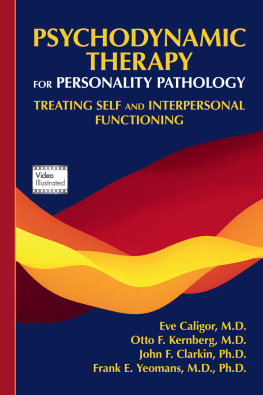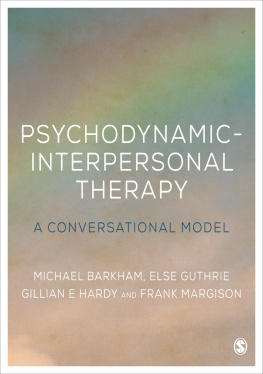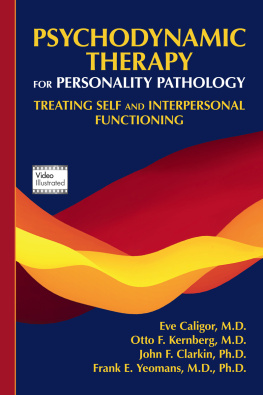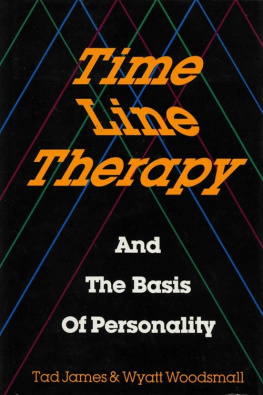Eve Caligor - Psychodynamic Therapy for Personality Pathology
Here you can read online Eve Caligor - Psychodynamic Therapy for Personality Pathology full text of the book (entire story) in english for free. Download pdf and epub, get meaning, cover and reviews about this ebook. year: 2018, publisher: American Psychiatric Association, genre: Home and family. Description of the work, (preface) as well as reviews are available. Best literature library LitArk.com created for fans of good reading and offers a wide selection of genres:
Romance novel
Science fiction
Adventure
Detective
Science
History
Home and family
Prose
Art
Politics
Computer
Non-fiction
Religion
Business
Children
Humor
Choose a favorite category and find really read worthwhile books. Enjoy immersion in the world of imagination, feel the emotions of the characters or learn something new for yourself, make an fascinating discovery.
- Book:Psychodynamic Therapy for Personality Pathology
- Author:
- Publisher:American Psychiatric Association
- Genre:
- Year:2018
- Rating:4 / 5
- Favourites:Add to favourites
- Your mark:
- 80
- 1
- 2
- 3
- 4
- 5
Psychodynamic Therapy for Personality Pathology: summary, description and annotation
We offer to read an annotation, description, summary or preface (depends on what the author of the book "Psychodynamic Therapy for Personality Pathology" wrote himself). If you haven't found the necessary information about the book — write in the comments, we will try to find it.
Psychodynamic Therapy for Personality Pathology — read online for free the complete book (whole text) full work
Below is the text of the book, divided by pages. System saving the place of the last page read, allows you to conveniently read the book "Psychodynamic Therapy for Personality Pathology" online for free, without having to search again every time where you left off. Put a bookmark, and you can go to the page where you finished reading at any time.
Font size:
Interval:
Bookmark:

THERAPY
TREATING SELF AND INTERPERSONAL
FUNCTIONING
THERAPY
FUNCTIONING
Eve Caligor, M.D.
Otto F. Kernberg, M.D.
John F. Clarkin, Ph.D.
Frank E. Yeomans, M.D., Ph.D.

Note: The authors have worked to ensure that all information in this book is accurate at the time of publication and consistent with general psychiatric and medical standards, and that information concerning drug dosages, schedules, and routes of administration is accurate at the time of publication and consistent with standards set by the U.S. Food and Drug Administration and the general medical community. As medical research and practice continue to advance, however, therapeutic standards may change. Moreover, specific situations may require a specific therapeutic response not included in this book. For these reasons and because human and mechanical errors sometimes occur, we recommend that readers follow the advice of physicians directly involved in their care or the care of a member of their family.
Books published by American Psychiatric Association Publishing represent the findings, conclusions, and views of the individual authors and do not necessarily represent the policies and opinions of American Psychiatric Association Publishing or the American Psychiatric Association.
If you wish to buy 50 or more copies of the same title, please go to www.appi.org/specialdiscounts for more information.
Copyright 2018 American Psychiatric Association Publishing
ALL RIGHTS RESERVED
First Edition
Manufactured in the United States of America on acid-free paper
22 21 20 19 18 5 4 3 2 1
American Psychiatric Association Publishing
800 Maine Ave. SW, Suite 900
Washington, DC 20024-2812
www.appi.org
Library of Congress Cataloging-in-Publication Data
Names: Caligor, Eve, 1956- author. | Kernberg, Otto F., 1928- author. | Clarkin, John F., author. | Yeomans, Frank E., 1949- author. | American Psychiatric Association Publishing, issuing body.
Title: Psychodynamic therapy for personality pathology : treating self and interpersonal functioning / Eve Caligor, Otto F. Kernberg, John F. Clarkin, Frank E. Yeomans.
Description: First edition. | Washington, DC : American Psychiatric Association Publishing, [2018] | Includes bibliographical references and index.
Identifiers: LCCN 2018008140 (print) | LCCN 2018008873 (ebook) | ISBN 9781615371815 (ebook) | ISBN 9781585624591 (alk. paper)
Subjects: | MESH: Psychotherapy, Psychodynamic | Personality Disorders therapy | Transference (Psychology) | Psychotherapymethods
Classification: LCC RC489.P72 (ebook) | LCC RC489.P72 (print) | NLM WM 420.5.P75 | DDC 616.89/14dc23
LC record available at https://lccn.loc.gov/2018008140
British Library Cataloguing in Publication Data
A CIP record is available from the British Library.
To Mike
Overview of TFP-E
BASIC TASKS, THE THERAPEUTIC RELATIONSHIP, AND STRATEGIES OF TREATMENT
Eve Caligor, M.D., is Clinical Professor of Psychiatry at Columbia University College of Physicians and Surgeons, and Director of Psychotherapy Division and Training and Supervising Analyst at the Columbia University Center for Psychoanalytic Training and Research, New York, New York.
Otto F. Kernberg, M.D., is Director of the Personality Disorders Institute at Weill Cornell Medical College, Professor of Psychiatry at Weill Cornell Medical College, and Training and Supervising Analyst at the Columbia University Center for Psychoanalytic Training and Research, New York, New York.
John F. Clarkin, Ph.D., is Codirector of the Personality Disorders Institute at Weill Cornell Medical College and Clinical Professor of Psychology in Psychiatry at Weill Cornell Medical College, New York, New York.
Frank E. Yeomans, M.D., Ph.D., is Clinical Associate Professor of Psychiatry at Weill Cornell Medical College, and Director of Training at the Personality Disorders Institute at Weill Cornell Medical College. He is also Adjunct Associate Professor of Psychiatry at the Columbia University Center for Psychoanalytic Training and Research, New York, New York.
The authors have indicated that they have no financial interests or other affiliations that represent or could appear to represent a competing interest with their contributions to this book.
WRITING A BOOK THAT COMBINES BOTH contemporary theory and clinical practice is an enormous feat. Eve Caligor and her coauthors accomplish this feat in Psychodynamic Therapy for Personality Pathology: Treating Self and Interpersonal Functioning. In this book (which grew out of and is a companion volume to the authors Transference-Focused Psychotherapy for Borderline Personality Disorder: A Clinical Guide []), the authors attempt to do many things and succeed at all of them. In fact, this book is a gift to anyone who wants to understand or to treat patients.
This is an exciting time for personality disorders. We are on the verge of having a model of personality pathology associated both with a model of the normal personality and with a model of treatment. This new model includes all points of view such as genetics, the brain, and, of course, psychology. This model includes an understanding of the development of each factor and the interactions between these factors. Eve Caligor and her coauthors explain it all.
First of all, in Section I of this book, the authors demonstrate in detail how the object relations model of the mind (developed by Otto Kernberg, a coauthor of this book) works for an understanding of personality, both normal and pathological. In the course of presenting this model, the authors focus on self experience and interpersonal functioning, both of which are brought together by identity consolidation. In so doing, they show how this object relations model fits with new findings from other fields, including neuroscience, attachment theory, developmental theory, and even relational psychoanalysis. They also discuss, among many other topics, how object relations theory interacts with other kinds of psychodynamics, how neurotic personality organization can be understood in contrast to borderline personality organization, and how Kernbergs theory differs from Kleinian theory. In addition, the reader is also treated to a guide for reading this book, to a concise definition of many terms, to many clinical examples, to numerous charts and tables providing a wide variety of information (for example, a clear hierarchy of defenses), and to many relevant references.
Most important, Caligor and coauthors demonstrate how the object relations model of personality fits with the Alternative Model for Personality Disorders in DSM-5, which also focuses on self experience and interpersonal relationships as the hallmarks of personality. The authors construct is an important development that invites readers to bring together contemporary psychiatry and contemporary psychoanalysis, as these two fields merge to develop an integrated theory of personality. Such an integration has been a long time in coming and is one of the authors greatest achievements.
In Section II, the authors turn to treatment. They outline the basics of transference-focused psychotherapyextended (TFP-E), both at the highest theoretical level and at the most experience-near, how-to level. Throughout, Caligor and coauthors explain that the aim of TFP-E is always to promote identity consolidation, with the goal of improving self experience and interpersonal functioning; TFP-E always involves an active, supportive, and positive attitude toward each patient. The authors explore the use of the therapeutic relationship, and how to understand and use transference and countertransference. They also outline the strategies of the treatment itself in a logical fashion. They explore how to understand and engage in treatment for narcissistic personality disorder and borderline personality disorder. Finally, they explore issues around tailoring the treatment for the individual patient, so that TFP-E is both principle driven and flexible. As a result, the reader comes away with both a theoretical understanding of the relationship among the patients personality organization, the therapeutic relationship, and treatment strategiesand a well-organized and humane guide for how to do dynamic psychotherapy.
Font size:
Interval:
Bookmark:
Similar books «Psychodynamic Therapy for Personality Pathology»
Look at similar books to Psychodynamic Therapy for Personality Pathology. We have selected literature similar in name and meaning in the hope of providing readers with more options to find new, interesting, not yet read works.
Discussion, reviews of the book Psychodynamic Therapy for Personality Pathology and just readers' own opinions. Leave your comments, write what you think about the work, its meaning or the main characters. Specify what exactly you liked and what you didn't like, and why you think so.











